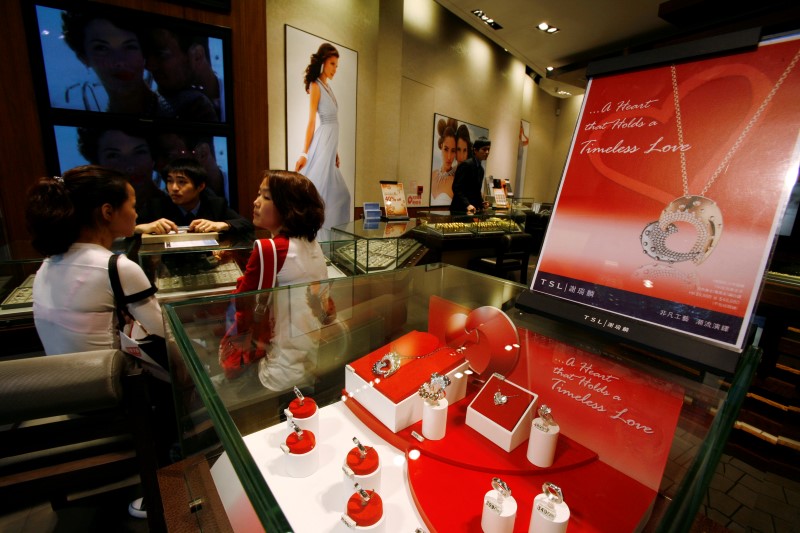By Jan Harvey
LONDON (Reuters) - China's penchant for luxury platinum jewellery is fading despite lower global prices, leaving world demand for the metal exposed to sharper decline.
China is by far the biggest market for platinum jewellery, making up more than 60 percent of global manufacturing use for the white metal in 2015.
A close to double-digit drop in Chinese platinum jewellery demand is expected this year, GFMS analysts said ahead of the industry gathering London Platinum Week, which starts on Monday.
This follows a seven percent drop in Chinese buying in 2015 fed into a four percent decline in global demand for jewellery made from the metal.
Consumer behaviour in China has shown a marked change, with spending on luxury goods suffering as growth slowed to its slowest in 25 years.
"It's not as if consumers aren't spending money, but they're not spending it on jewellery in the way they used to," said Philip Klapwijk, director of Hong Kong-based Precious Metals Insights.
"Consumers' discretionary purchasing power is being spent on other things -- white goods, and certainly tourism. More Chinese tourists are going abroad, and that also means during important public holidays, fewer people are visiting department stores."
Carmakers who use platinum in catalytic converters, are the biggest overall buyers of platinum, accounting for 40 percent of global demand.
However, when broken down on a regional basis, Chinese jewellers are the biggest single consumers of platinum, buying 1.561 million ounces of the metal last year.
CLEAN-UP WEIGHS
Also affecting the luxury sector is a crackdown on corruption, launched by Beijing in 2012. That has also made officials reluctant to be seen to be buying expensive jewellery.
While jewellery sales overall are down, gold is proving a strong competitor against platinum in terms of market share, with white gold in particular a popular alternative.
In terms of marketing, retailers have focused more on gold in recent years, since a sharp price drop in early 2013 drove physical gold sales to record highs.
A slide in platinum prices to below $1,000 an ounce last year for the first time since 2009 has not had a commensurate effect, however.
While the white metal has been trading below the price of gold on global markets since the start of 2015, that has not been reflected at the consumer level in China.
"Unlike those gold products that are sold by weight..., our platinum jewellery is sold at fixed price," a spokesman for Chow Tai Fook, China's largest jewellery retailer by market value, said. "Thus we do not see any significant impact on the demand for platinum jewellery in relation to the ups and downs of the platinum price."
In part, the lack of price elasticity is due to the higher cost of working platinum, a much harder metal than gold, into jewellery. Platinum jewellery also tends to be gem-set, making its cost less reliant on the metal price.
Price visibility for platinum among consumers tends to be patchier than for gold, which is often bought as an investment.
However, this awareness is rising, leading some consumers to question the value of buying platinum jewellery without more of a discount, analysts said.
"Consumers are far more educated today," GFMS analyst Cameron Alexander said.

"They fully understand the markup structure and where the metals are trading on a spot basis, so when they could see no - or only moderate - movements in the retail price when platinum was trading at such low levels it was seen as overpriced."